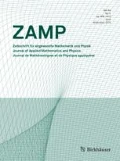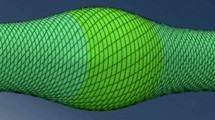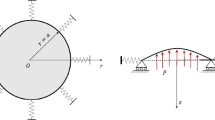Abstract
We provide an analytic derivation of the bifurcation conditions for localized bulging in an inflated hyperelastic tube of arbitrary wall thickness and axisymmetric necking in a hyperelastic sheet under equibiaxial stretching. It has previously been shown numerically that the bifurcation condition for the former problem is equivalent to the vanishing of the Jacobian determinant of the internal pressure P and resultant axial force N, with each of them viewed as a function of the azimuthal stretch on the inner surface and the axial stretch. This equivalence is established here analytically. For the latter problem for which it has recently been shown that the bifurcation condition is not given by a Jacobian determinant equal to zero, we explain why this is the case and provide an alternative interpretation.

Similar content being viewed by others
References
Mallock, A.: Note on the instability of India-rubber tubes and balloons when distended by fluid pressure. Proc. Roy. Soc. A 49, 458–463 (1891). https://doi.org/10.1098/rspl.1890.0116
Yin, W.-L.: Non-uniform inflation of a cylindrical elastic membrane and direct determination of the strain energy function. J. Elast. 7, 265–282 (1977). https://doi.org/10.1007/BF00041073
Chater, E., Hutchinson, J.W.: On the propagation of bulges and buckles. J. Appl. Mech. 51, 269–277 (1984). https://doi.org/10.1115/1.3167611
Kyriakides, S., Chang, Y.-C.: On the inflation of a long elastic tube in the presence of axial load. Int. J. Solids Struct. 26(9–10), 975–991 (1990). https://doi.org/10.1016/0020-7683(90)90012-K
Kyriakides, S., Chang, Y.-C.: The initiation and propagation of a localized instability in an inflated elastic tube. Int. J. Solids Struct. 27(9), 1085–1111 (1991). https://doi.org/10.1016/0020-7683(91)90113-T
Pamplona, D.C., Goncalves, P.B., Lopes, S.R.X.: Finite deformations of cylindrical membrane under internal pressure. Int. J. Mech. Sci. 48(6), 683–696 (2006). https://doi.org/10.1016/j.ijmecsci.2005.12.007
Goncalves, P.B., Pamplona, D., Lopes, S.R.X.: Finite deformations of an initially stressed cylindrical shell under internal pressure. Int. J. Mech. Sci. 50(1), 92–103 (2008). https://doi.org/10.1016/j.ijmecsci.2007.05.001
Rodríguez, J., Merodio, J.: A new derivation of the bifurcation conditions of inflated cylindrical membranes of elastic material under axial loading. application to aneurysm formation. Mech. Re. Commun. 38(3), 203–210 (2011). https://doi.org/10.1016/j.mechrescom.2011.02.004
Alhayani, A.A., Rodríguez, J., Merodio, J.: Competition between radial expansion and axial propagation in bulging of inflated cylinders with application to aneurysms propagation in arterial wall tissue. Int. J. Eng. Sci. 85, 74–89 (2014). https://doi.org/10.1016/j.ijengsci.2014.08.008
Alexander, H.: Tensile instability of initially spherical balloons. Int. J. Eng. Sci. 9, 151–160 (1971). https://doi.org/10.1016/0020-7225(71)90017-6
Kanner, L.M., Horgan, C.O.: Elastic instabilities for strain-stiffening rubber-like spherical and cylindrical thin shells under inflation. Int. J. Non-linear Mech. 42, 204–215 (2007). https://doi.org/10.1016/j.ijnonlinmec.2006.10.010
Horny, L., Netusil, M., Horak, Z.: Limit point instability in pressurization of anisotropic finitely extensible hyperelastic thin-walled tube. Int. J. Non-linear Mech. 77, 107–114 (2015). https://doi.org/10.1016/j.ijnonlinmec.2015.08.003
Fu, Y.B., Pearce, S.P., Liu, K.K.: Post-bifurcation analysis of a thin-walled hyperelastic tube under inflation. Int. J. Non-linear Mech. 43(8), 697–706 (2008). https://doi.org/10.1016/j.ijnonlinmec.2008.03.003
Fu, Y.B., Liu, J.L., Francisco, G.S.: Localized bulging in an inflated cylindrical tube of arbitrary thickness-the effect of bending stiffness. J. Mech. Phys. Solids 90, 45–60 (2016). https://doi.org/10.1016/j.jmps.2016.02.027
Ye, Y., Liu, Y., Fu, Y.B.: Weakly nonlinear analysis of localized bulging of an inflated hyperelastic tube of arbitrary wall thickness. J. Mech. Phys. Solids 135, 103804 (2020). https://doi.org/10.1016/j.jmps.2019.103804
Lin, Z., Li, L., Ye, Y.: Numerical simulation of localized bulging in an inflated hyperelastic tube with fixed ends. Int. J. Appl. Mech. 12(10), 2050118 (2020). https://doi.org/10.1142/S1758825120501185
Wang, S., Guo, Z., Zhou, L., Li, L., Fu, Y.B.: An experimental study of localized bulging in inflated cylindrical tubes guided by newly emerged analytical results. J. Mech. Phys. Solids 124, 536–554 (2019). https://doi.org/10.1016/j.jmps.2018.11.011
Varatharajan, N., DasGupta, A.: Study of bifurcation in a pressurized hyperelastic membrane tube enclosed by a soft substrate. Int. J. Non-linear Mech. 95, 233–241 (2017). https://doi.org/10.1016/j.ijnonlinmec.2017.05.004
Wang, J., Althobaiti, A., Fu, Y.B.: Localized bulging of rotating elastic cylinders and tubes. J. Mech. Mater. Struct. 12(4), 545–561 (2017). https://doi.org/10.2140/jomms.2017.12.545
Wang, J., Fu, Y.B. (2018).: Effect of double-fibre reinforcement on localized bulging of an inflated cylindrical tube of arbitrary thickness. J. Eng. Math. 109(1), 21–30. https://doi.org/10.1007/s10665-017-9899-5
Liu, Y., Ye, Y., Althobaiti, A., Xie, Y.X.: Prevention of localized bulging in an inflated bilayer tube. Int. J. Mech. Sci. 153, 359–368 (2019). https://doi.org/10.1016/j.ijmecsci.2019.01.028
Ye, Y., Liu, Y., Althobaiti, A., Xie, Y.X.: Localized bulging in an inflated bilayer tube of arbitrary thickness: effects of the stiffness ratio and constitutive model. Int. J. Solids Struct. 176, 173–184 (2019). https://doi.org/10.1016/j.ijsolstr.2019.06.009
Hejazi, M., Hsiang, Y., Srikantha Phani, A.: Fate of a bulge in an inflated hyperelastic tube: theory and experiment. Proc. Roy. Soc. A 477(2247), 20200837 (2021). https://doi.org/10.1098/rspa.2020.0837
Fu, Y.B., Jin, L., Goriely, A.: Necking, beading, and bulging in soft elastic cylinders. J. Mech. Phys. Solids 147, 104250 (2021). https://doi.org/10.1016/j.jmps.2020.104250
Emery, D., Fu, Y.B.: localized bifurcation in soft cylindrical tubes under axial stretching and surface tension. Int. J. Solids Struct. 219, 23–33 (2021). https://doi.org/10.1016/j.ijsolstr.2021.02.007
Emery, D., Fu, Y.B.: Post-bifurcation behaviour of elasto-capillary necking and bulging in soft tubes. Proc. R. Soc. A 477, 20210311 (2021). https://doi.org/10.1098/rspa.2021.0311
Wang, M., Jin, L.S., Fu, Y.B.: Axi-symmetric necking versus Treloar-Kearsley instability in a hyperelastic sheet under equibiaxial stretching. Math. Mech. Solids (February 2022). https://doi.org/10.1177/10812865211072897
Ogden, R.W.: Non-linear elastic deformations. Ellis Horwood, New York (1984)
Haughton, D.M., Ogden, R.W.: Bifurcation of inflated circular cylinders of elastic material under axial loading—I. Exact theory for thick-walled tubes. J. Mech. Phys. Solids 27(5-6), 489–512 (1979). https://doi.org/10.1016/0022-5096(79)90001-2
Kirchgässner, K.: Wave-solutions of reversible systems and applications. J. Diff. Eq. 45(1), 113–127 (1982). https://doi.org/10.1016/0022-0396(82)90058-4
Mielke, A.: Hamiltonian and Lagrangian flows on center manifolds, with applications to elliptic variational problems. Springer-Verlag, Berlin Lecture Notes in Mathematics (1991)
Haragus, M., Iooss, G.: Local bifurcations, center manifolds, and normal forms in infinite-dimensional dynamical systems. Springer, London (2011)
Wang, M., Fu, Y.B.: Necking of a hyperelastic solid cylinder under axial stretching: Evaluation of the infinite-length approximation. Int. J. Eng. Sci. 159, 103432 (2021). https://doi.org/10.1016/j.ijengsci.2020.103432
Acknowledgements
This work was supported by the National Natural Science Foundation of China (Grant No. 12072224).
Author information
Authors and Affiliations
Corresponding author
Additional information
Publisher's Note
Springer Nature remains neutral with regard to jurisdictional claims in published maps and institutional affiliations.
Appendix: A Proof of equality (2.58)
Appendix: A Proof of equality (2.58)
To prove (2.58), we start by analyzing the linearized forms of (2.57). Assuming that the perturbed configuration is also uniform, we show below that the linearized forms of the following two equations
Let us denote by \(\overline{\varvec{\sigma }}\) and \(\varvec{\sigma }\) the Cauchy stresses associated with the uniformly inflated configuration and perturbed configuration, respectively. Then it follows from the definition of the incremental stress tensor \(\varvec{\chi }\) that
Note that the incremental deformation gradient \(\varvec{\eta }\) is diagonal since the perturbed configuration is uniform.
Specifying (A.1) to the perturbed configuration, we see from the definition of \(P^*\) that the resulted equation takes the form
where \({\tilde{r}}=r+u\) denotes the radius of the tube after perturbation, and \({\tilde{a}}={\tilde{r}}(A)\) and \({\tilde{b}}={\tilde{r}}(B)\). Substituting (A.3) into (A.4) and making a change of variables (integration by substitution) by applying the incompressibility equality
where \({\tilde{\lambda }}_z\) is the axial stretch of the tube in the perturbed configuration, we obtain
When expanded to linear order, we have
Thus by ignoring nonlinear terms, one can simplify (A.6) as
where we have used incompressibility constraint \( \eta _{11}+\eta _{22}+\eta _{33}=0. \) The radial equilibrium for the unperturbed deformation implies that
Using integration by parts, one can write the second integral in (A.8) as
where use has been made of the boundary conditions \({\overline{\sigma }}_{33}|_{r=a}=-P\) and \({\overline{\sigma }}_{33}|_{r=b}=0\). In view of incompressibility constraint and the fact that \(\eta _{22}\) is constant since the perturbed configuration is uniform, we deduce that
Putting these together, we see that the linearized form of (A.1) can be written as
which agrees with (2.42) (note that \(\chi _{32}=0\) for uniform inflations).
Equation (A.2) applied to the perturbed configuration can be written as
Using (A.3) and (A.5), we can rewrite the above equation as
Its linearized form is
which is the same as (2.43).
Now let \({\tilde{\lambda }}_a\) and \({\tilde{\lambda }}_z\) be the two principal stretches of the perturbed configuration, thus
Then equation (A.1) applied to the unperturbed and perturbed configurations takes the form \( -P^*(\lambda _a,\lambda _z)+P=0\) and \(-P^*({\tilde{\lambda }}_a,{\tilde{\lambda }}_z)+P=0\), respectively. Subtraction of these two equalities yields
In a similar way, we can deduce from (A.2) that
where \({\tilde{b}}={\tilde{r}}(B)\) is the outer radius of the tube after perturbation. Linearizing the above two equations at \((\lambda _a,\lambda _z)\) followed by the use of (A.16) and (A.17), we obtain
Comparing them with (2.39) and (2.44), we conclude that
In view of (2.49), it follows from (A.22) that \(\Omega (\lambda _a,\lambda _z)\) can be expressed as
which completes the proof.
Rights and permissions
About this article
Cite this article
Yu, X., Fu, Y. An analytic derivation of the bifurcation conditions for localization in hyperelastic tubes and sheets. Z. Angew. Math. Phys. 73, 116 (2022). https://doi.org/10.1007/s00033-022-01748-2
Received:
Revised:
Accepted:
Published:
DOI: https://doi.org/10.1007/s00033-022-01748-2




